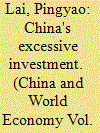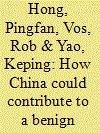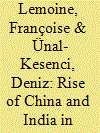|
|
|
Sort Order |
|
|
|
Items / Page
|
|
|
|
|
|
|
| Srl | Item |
| 1 |
ID:
084745


|
|
|
|
|
| Publication |
2008.
|
| Summary/Abstract |
This paper uses an agricultural trade policy simulation model to quantitatively evaluate the effects of Blue Box policy reform on agricultural production and trade, and further provides specific proposals regarding China's reform position. The results indicate that, if the reform could achieve a reduction in distorting supports in more developed countries, China's total agricultural production would increase, accompanied by a decrease in agricultural imports and a slight increase in exports. In terms of social welfare, producers would gain significantly, consumers would lose and government would not suffer greatly, which is in accordance with current agricultural policies in China. As a core member of G20, China should approve a subsidy level as low as possible required by Blue Box to achieve "substantial reductions in trade-distorting domestic supports".
|
|
|
|
|
|
|
|
|
|
|
|
|
|
|
|
| 2 |
ID:
084743


|
|
|
|
|
| Publication |
2008.
|
| Summary/Abstract |
China's economy has witnessed serious excessive investment over the past 5 years, mainly in the infrastructure and real estate. Excessive investment has adverse impacts on both economic growth and macroeconomic stability. The main causes of this excessive investment are inappropriate growth strategies, low interest rates and weak constraints on government investment expenditure. To effectively control excessive investment, China needs to adjust its growth strategy, to speed up the process of interest rate marketization, and reform the existing public expenditure system.
|
|
|
|
|
|
|
|
|
|
|
|
|
|
|
|
| 3 |
ID:
084744


|
|
|
|
|
| Publication |
2008.
|
| Summary/Abstract |
This paper considers five indicators of excess liquidity to verify its existence in China. Based on the analysis, we argue that the People's Bank of China and other banks in China are responsible for the excess liquidity in China. Other factors, such as the excess savings resulting from the poor social security network, the asset bubble and the foreign exchange system, fuel banks with abundant liquidity. To tackle the problem of excess liquidity and direct capital into productive sectors, the traditional use of monetary policy alone is not sufficient. The semi-administrative tool "window guidance" and other macroeconomic control methods are required.
|
|
|
|
|
|
|
|
|
|
|
|
|
|
|
|
| 4 |
ID:
084742


|
|
|
|
|
| Publication |
2008.
|
| Summary/Abstract |
Our study shows that China could contribute to an orderly global rebalancing using a package of policies to stimulate its domestic consumption. These policies include a progressive appreciation of the RMB, fiscal stimulation by increasing expenditure on education, health care, social safety nets and poverty reduction, income policies to reduce inequality and to strengthen wage income, and reforms of the financial system to improve financial efficiency and to mitigate financial constraints. By implementing such policies, China's external surplus could be narrowed and its domestic imbalances improved. The excessively high savings rate could be lowered and the share of household consumption increased, even though GDP growth would moderate slightly.
|
|
|
|
|
|
|
|
|
|
|
|
|
|
|
|
| 5 |
ID:
084740


|
|
|
|
|
| Publication |
2008.
|
| Summary/Abstract |
Regression analysis is used to tease out the relative significance of influences on the supply and demand for the exports of China and India. On the supply side, the value-added tax in China has discouraged export supply. The elimination of the rebate on those taxes will discourage exports. Higher wages discourage exports, but the share of exports by foreign invested enterprise is a positive influence, as is a higher share of value added in output and greater experience in exporting. On the demand side, exports depend in part on aggregate income levels in importing countries. Relative wages have been more important than exchange rates in determining the demands for Chinese and Indian exports. This evidence does not support the pressures for a devaluation of the RMB. There is also evidence of the positive significance of the accustomization of purchasers to buying Chinese exports.
|
|
|
|
|
|
|
|
|
|
|
|
|
|
|
|
| 6 |
ID:
084746


|
|
|
|
|
| Publication |
2008.
|
| Summary/Abstract |
The increase in the movement of people from rural to urban areas since the mid-1980s represents the largest labor migration ever experienced in China. Because migration is a process of selection, it is imperative that the major dynamics determining the selection are studied. What are the critical characteristics of migrants that help them to realize their mobility from rural areas to urban areas? While educational attainment, gender, age, marital status and personal skills are important variables in the selection process, the present paper examines how social networks (guanxi connections) play a significant role in the process of migration selection in China. A case study from one of the northern villages in rural China is used to explore how social networks have shaped and given meaning to migration. The present paper elaborates on how people's social mobility has coincided with and been reinforced by people's physical mobility.
|
|
|
|
|
|
|
|
|
|
|
|
|
|
|
|
| 7 |
ID:
084747


|
|
|
|
|
| Publication |
2008.
|
| Summary/Abstract |
Drawing on a dataset covering a large number of randomly sampled villages across China, the present paper examines the issue of residential solid waste management service provision in rural China. Using a logistic model we evaluate the impacts of different factors on service provision at the village level with regard to residential solid waste disposal. These factors include the environmental pressures caused by residential solid waste generation, the financial capacity of the Villagers' Committee, village elections and the individual characteristics of village heads. We find that living density, village per capita income, the ratio of irrigated land, and the per capita profit submitted by village enterprises to the Villagers' Committee all have positive impacts on service provision. Moreover, village heads who are popularly elected by villagers are more likely to provide services that satisfy voters' demands.
|
|
|
|
|
|
|
|
|
|
|
|
|
|
|
|
| 8 |
ID:
084741


|
|
|
|
|
| Publication |
2008.
|
| Summary/Abstract |
China and India are two demographic giants that have become big developing economic powers. They have maintained their specialization in textiles and developed outward-oriented sectors linked to new technologies, taking advantage of offshoring and outsourcing. Their increasing contribution to international trade is changing the world supply and demand of manufactured goods, primary goods and services. They are new leaders in the international division of labor, but beyond technological catch-up, their challenge is quality upgrading. Both countries are increasingly contributing to global economic growth, but they cannotyet trigger the growth of the rest of the world by themselves
|
|
|
|
|
|
|
|
|
|
|
|
|
|
|
|
|
|
|
|
|